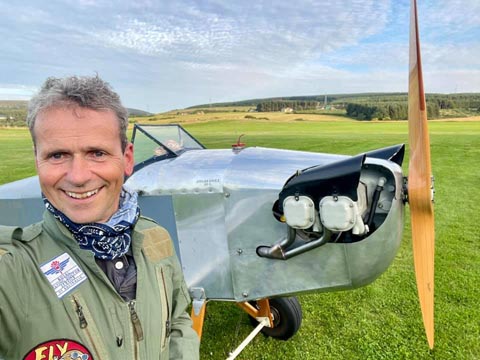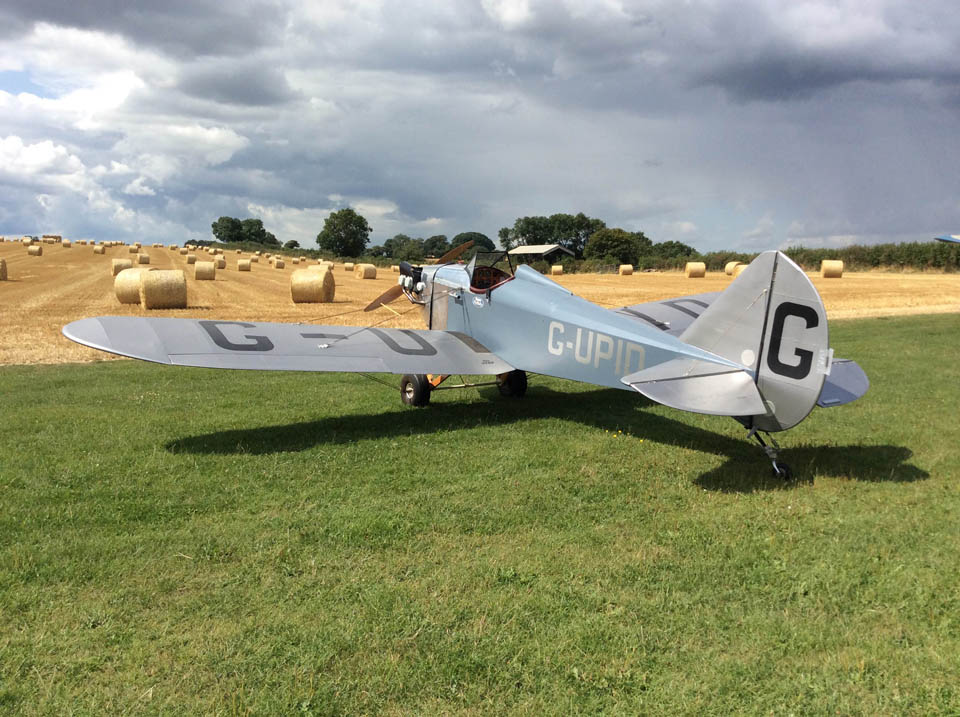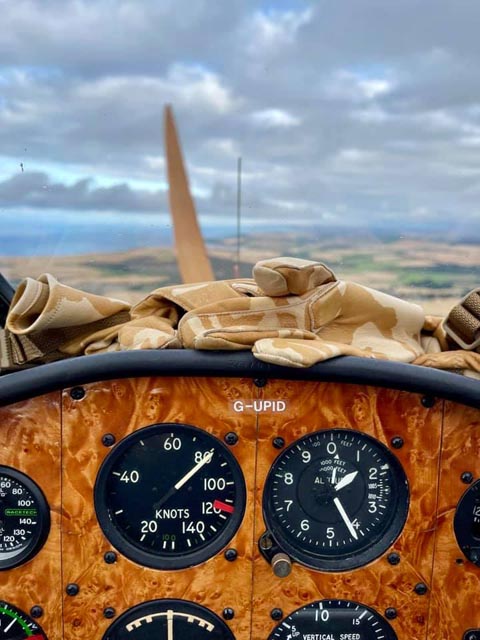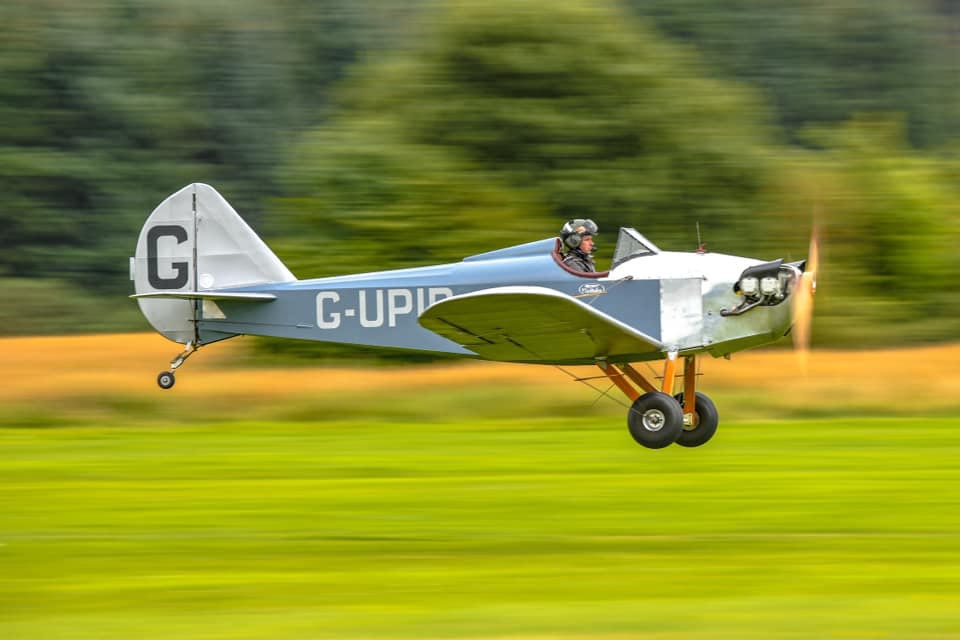[Iain and two partners bought Fly Baby G-UPID
in 2021. He posted this report to the Fly Baby Facebook
page on 28 September, 2021, and kindly gave me permission to
repost it to the web page. Pictures were provide both by
Iain and the previous owner, Roy Taylor.]
Flying the Bowers Fly Baby
…or, the initial impressions of a novice Fly Baby pilot.
By Iain MacDonald
 I am a general aviation pilot based in the
beautiful North East of Scotland. Having gained my pilots
licence on the Centenary of the Wright Brothers first flight
in 2003 (after an earlier life with intermittent flying
experience since the age of 16) my plan was always to
fly vintage tailwheel aircraft.
I am a general aviation pilot based in the
beautiful North East of Scotland. Having gained my pilots
licence on the Centenary of the Wright Brothers first flight
in 2003 (after an earlier life with intermittent flying
experience since the age of 16) my plan was always to
fly vintage tailwheel aircraft. This was followed by a period of flying a with a group who owned a French-built Jodel to gain tailwheel experience, followed by several years of weekend flying experience in a de Havilland DH 82a Tiger Moth, interspersed with jointly owning a Cessna 140A, another Jodel, a Cessna 120 (which we still own and fly), a Pietenpol Aircamper (also still in our group ownership) and a Druine Turbulent.
In 2014 I read two Flight Test reports in U.K. flying magazines (Flyer magazine May 2014 and the LAA magazine November 2014) about a newly-built Bowers Fly Baby. I immediately fell in love with the beautiful looking single seat vintage style open cockpit aeroplane and considered writing to the builder (Roy Taylor) to ask him if he would ever sell this beautiful machine.
I didn’t do this and seven years went by until my hangar mate (Rick Phillips) who incidentally owns and built one of the only other Fly Baby aircraft in the U.K. (there are four on the U.K. register) sent me a Devon Strut (local flying group) newsletter. In this was advertised G-UPID, the Fly Baby which I had so admired. My friends and I immediately agreed to buy this aircraft and ID came into our ownership in the middle of August this year. Rick flew this Fly Baby from Devon (far south of England) to our airfield in the North of Scotland in five hops over two days (initially leaving Devon in low cloud and encountering rain on his first flight). ID safely arrived at Easterton Airfield in NE Scotland on 15th August 2021.

Flying the Fly Baby
I was thoroughly briefed by Rick on external inspection of the Fly Baby. 17th August was the time for my first flight and conditions were good with light winds and no other aeroplanes or gliders flying at the time. The cockpit is spacious and comfortable, my only problem (despite being 5’11”) was that the rudder pedals were at full stretch for me (Roy, the previous owner, must have had very long legs!). India Delta started immediately after pressing
the starter button after a couple of primes, and the
Continental C90 engine purred at 1,200 RPM for 5 minutes of
warm up time. The oil pressure sat at 40 PSI and temperature
started to come off the stop. After 5 minutes I released the
brakes (RV9 toe brake modification) and found that taxiing was
easy on grass and without complications. Weaving gently was
necessary to see clearly over the nose. After power checks
performed at 1,700 RPM I entered and lined up on the grass
strip for my first departure.
India Delta started immediately after pressing
the starter button after a couple of primes, and the
Continental C90 engine purred at 1,200 RPM for 5 minutes of
warm up time. The oil pressure sat at 40 PSI and temperature
started to come off the stop. After 5 minutes I released the
brakes (RV9 toe brake modification) and found that taxiing was
easy on grass and without complications. Weaving gently was
necessary to see clearly over the nose. After power checks
performed at 1,700 RPM I entered and lined up on the grass
strip for my first departure. After essential pre-departure checks (which are brief and essentially include fuel “on” and sufficient, throttle friction tight, primer locked, controls free, harness tight, carburettor heat cold and gauges in the green) I opened the throttle gently at first and gradually increased to full power (approximately 2,300 RPM registering). The stick was in a neutral position and I had planned to apply forward pressure and lift the tail. However, before I knew it, I was airborne with the Fly Baby feeling very buoyant yet with less than 40 knots registered on the ASI. I held the nose down until 60 knots was achieved and then added slight back pressure to maintain this speed.
The rate of climb was fantastic compared to my previous mount (the Turbulent) and before I knew it we were passing 1000’ and going up rapidly. On this flight (and the first few take offs) my error was to not appreciate the amount of right rudder required to maintain a straight track - a steady and firm pressure on the right pedal is required as the ground roll increases in speed and at take off whilst on full power if drift to the left is to be avoided. Gyroscopic precession, P-factor etc is very pronounced in our C90 powered machine.
This aeroplane from the first flight onwards has been a delight to fly. It feels like a larger aeroplane in the cruise, very stable and rides mild turbulence with ease. ID has a very slight nose-down tendency with a full fuel tank of fuel (60 litres) in the initial cruise (2,300 RPM, 78 knots) but within 20 minutes this seems to balance out so that the aircraft can be flown hands and feet off. As briefed, the landing wires appear slack whilst flying, so I was not concerned about this. The visibility is unrivalled and the seating position extremely comfortable with excellent protection from the slip stream by the windscreen.
The Fly Baby is very easy to manoeuvre with only very light rudder input to balance the aileron input. Power reduction is accompanied by an immediate (yet easily controlled) sink. This is an aeroplane which immediately gives the pilot a huge amount of confidence and is an absolute joy to fly.
Landing
Returning to base after the first flight, I reduced power from 2,300 RPM to approximately 2,000 RPM going downwind with carburettor heat on. 1,800 - 2,000 RPM seems to give 65 - 70 knots on the downwind leg and a controllable rate of sink. A curved base leg to final approach and subsequent selection of 1,500 RPM for finals gives a fairly impressive rate of sink which can be controlled easily by application or cutting of power. Power was chopped in the flare with carburetor heat selected cold in case a go-around was required.My first seven or eight landings were all varied - whilst attempting 3 point landings I managed everything between a smooth wheel landing to a variety of three-pointers with/without added skips.
However, despite the rigid undercarriage, the Fly Baby has (so far) been extremely forgiving to land on grass and resulted in gentle landings. Flaring at 60 knots seems to allow sufficient energy for a gentle float and touch down. Subsequent roll out has been easy. I have not yet flown this aeroplane from a hard runway but I am assured that it has impeccable habits on concrete too!
With 12 flights under my belt in the first month since the Fly Baby has been in our ownership, I greatly look forward to getting to know this fantastic aeroplane over the Autumn and Winter and to start some touring to local airfields, which I’m sure my two co-owners (Alec and Brian) hope to do also.
Iain Macdonald
Scotland, U.K.
September 2021

 Return to the Stories Page
Return to the Stories Page